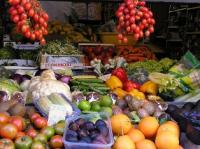Are healthful foods really more expensive?
 Creative Commons photo by keepps via. flickr
Creative Commons photo by keepps via. flickr
A cost comparison of more and less nutritious food choices in U.S. supermarkets
A common belief is that foods that are “good for you” are more expensive than those that are less healthful. However, the results of a recent study contradict the notion that food shoppers must either spend more money to eat a healthful diet or save money by sacrificing the nutritional value of their food selections.
Dr. David Katz, MD, MPH, director of the Yale-Griffin Prevention Research Center, and his colleagues devised this study, just published in Public Health Nutrition. They recruited a volunteer to shop in typical U.S. supermarkets for eight categories of food products (breads, cereal bars, cereals, chips, cookies, crackers, juices, and peanut butters). The volunteer visited six supermarkets in Jackson County, Missouri and selected 131 items, 75 percent of which were brand name products and 25 percent of which were store brand items.
For each category of products, the volunteer followed specific guidelines based on the Nutrition Facts panel and ingredient list on food packages to choose examples of “more nutritious” and “less nutritious” foods. The source of these guidelines was the Nutrition Detectives educational program, which teaches elementary school children a set of “5 clues” to make healthful food choices. Katz’s team validated the nutritional quality of these foods with the NuVal Nutritional Scoring System, currently used in approximately 1,000 supermarkets in 25 states, which assigns a score ranging from 1 to 100 to represent the overall nutritional quality of more than 90,000 individual food products. The research team standardized the prices based on 100 gram portions of each product, and then compared the standardized prices.
Within individual categories of food products, Katz’s team did find some significant differences in standardized prices of foods. The “more nutritious” breads, crackers, and peanut butters cost more on average than their “less nutritious” counterparts. On the other hand, the “more nutritious” cereals cost less on average than their “less nutritious” counterparts. In addition, there were no significant price differences between “more nutritious” and “less nutritious” chips, cereal bars, cookies, or juices. Overall, when the researchers examined all eight categories of the “more nutritious” products combined, as if they were together in one grocery cart, they found no major difference the average price of per item compared to the average price per item in all eight categories of “less nutritious” products.
“When you look at individual foods in the grocery store, some of the items that are good for your health may cost a bit more than the ‘less healthful’ items. However, as you fill up the cart with groceries, the average cost of a grocery cart of ‘more healthful’ foods is likely to even out compared to a cart of ‘less healthful’ foods,” Katz explained. “Typically, the value of food is thought of in terms of ‘calories per dollar.’ But now that we’re facing an epidemic of obesity, when more calories per dollar simply means the chance to gain more weight at no extra charge, thinking in terms of ‘nutrition per dollar’ may offer the better value.”
Katz noted that making even small changes can add up to have a significant improvement in people’s diets. “Often food shoppers can trade up nutritionally at no increased cost. While some nutritious foods cost more, the problem much of the time is that people simply lack the means to identify the more nutritious foods reliably and conveniently. For those empowered to do so, there prove to be many choices available that are both nutritious and economical. Nutrition education or in-store nutrition guidance can address this issue.”
Katz acknowledged that while choosing more nutritious foods without an increased financial burden may be possible for many shoppers, they still need a minimum income level to afford a healthful diet. “We don’t mean to imply that people of all income levels can afford to eat a diet that is healthful overall, and we recognize that some kinds of healthful foods, such as fruits and vegetables, may still be out of reach for many people. We need to address this with policies, such as linking food price directly to objectively measured nutritional quality, especially for those struggling financially. We have the means to do this, and should put it to the test.”
Citation
Katz DL, Doughty K, Njike V, Treu JA, Reynolds J, Walker J, Smith E, Katz C. A cost comparison of more and less nutritious food choices in US supermarkets. Public Health Nutr. 2011 Feb 28:1-7. [Epub ahead of print] PubMed PMID: 21356146.
More information about:



 del.icio.us
del.icio.us Digg
Digg












Post your comment